
| Home | Contact Us | Site Map | Search |
 |
||||
|
|
|
|
|
Lisa Hancock wanted to be a nurse since first grade. Her high school guidance counselors encouraged her to study computers in college instead, but she hated it so much that she soon dropped out. She spent 24 years raising her two daughters and working for her father in the family printing business. When he decided to retire, Hancock enrolled at Montgomery College’s nursing program. Hancock and her oldest daughter, Kellie, were both college students at the same time. A CEU requirement brought Hancock and several classmates to the CC for a workshop and tour, and they heard how great it was to work here. "What thrilled me beyond everything is the research that’s being done here and nowhere else in the world," Hancock said. "The atmosphere in this department, floor, and hospital is amazing. The support and teamwork is so different from anything else I’ve seen in my clinical work. Here I can actually give real patient care. I’m not just a medicine dispenser." The CC customer-service ethic also made a big impression on this newcomer. "Everywhere people say good morning, and you can’t walk 10 feet looking lost without someone stopping to help you," she said.
|
 |
| Tim Ames, chief of the review support branch of FDA's office of Generic Drugs, spoke to a full house at Masur Auditorium.
|
The CC Pharmacy Department’s 13th annual Pharmacotherapy Frontiers symposium packed Masur Auditorium on April 21, a sunny Saturday morning, with about 350 pharmacists and pharmacy technicians seeking accredited pharmacy continuing education (CE).
Although accredited pharmacy CE is widely available online at no cost, it is unusual for a live program to be free, without commercial sponsors, and feature a high-level of expertise provided by speakers from NIH and FDA. "It would be difficult for any other organization to offer this type of expertise every year at no cost," according to Captain Chris Chamberlain, organ transplant clinical pharmacy specialist and one of the program organizers.
The symposium's four speakers for 2007 included Jerry Overman, clinical pharmacy specialist for NIMH and the CC's Inpatient Pharmaceutical Care Section, and Ayana Rowley, ambulatory care pharmacotherapeutics and research fellow in the CC's Ambulatory Pharmaceutical Care Section.
Two former CC pharmacists—Bona Benjamin, now director of medication use quality improvement for the American Society of Health-System Pharmacists, and Tim Ames, now chief of the review support branch of FDA’s Office of Generic Drugs—also spoke.
Ames provided an overview of FDA’s role in the generic drug approval process, including the Abbreviated New Drug Application review process, and how it assures that generic drugs are safe and effective.
"Because very few individuals—those directly involved with our office or academia, including many health-care professionals—understand what is involved in approving a generic drug product, this type of presentation is important in dispelling misperceptions about generic drugs" Ames said.
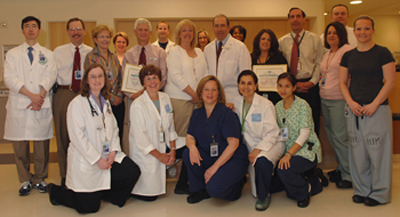 |
| ICU CRIS team members and additional ICU and CC staff at the award presentation included (Back row, from left): Brad Moriyama, Dr. James Shelhamer, Dr. Naomi O’Grady, Connie Kotefka, Dr. Peter Eichacker, Dr. David Vitberg, Deborah Kolakowski, Christine Callahan, CC Director Dr. John I. Gallin, Gina Ford, Susy Postal, Dr. Henry Masur, Dr. John Beigel, Carrie Patricola, and Lauren Stringi. (Front row, from left): Therese Kent, Nancy Ames, Pamela Horwitz, Parvin Safavi, and Gloria Cruz. |
The ICU CRIS interdisciplinary team on May 8 received the CC’s third Patient Safety Champion Award, which is given annually to individuals or teams demonstrating a sustained commitment to a safe patient environment.
The team, created in 2004, identified and implemented several initiatives to benefit patients in the ICU and throughout the CC. These included a CRIS medication start time alert; the ability to view results in some order forms to avoid duplicate blood draws; 18 computers on wheels for bedside nurse access to patient data; a critical care assessment flowsheet to standardize ICU patient information; and the ICU profiles and continuous venous-venous hemofiltration order sets.
 |
|
Rosane Suleiman, clinical research nurse on 3SWS, reviews patient data using a computer on wheels, one of the initiatives developed by the team. |
Susy Postal accepted the award on behalf of the CRIS team and Peter Eichacker accepted the ICU team’s award.
Congratulations to team members: Allison Adams-McLean, Nancy Ames, Deborah Kolakowski, and Connie Kotefka, nursing; John Beigel, Eichacker, Therese Kent, Henry Masur, Nancy Munro, and James Shelhamer, CCMD; Gina Ford, OD; Jon McKeeby and Postal, DCRI; Brad Moriyama, pharmacy; and Richard Sherry, NCI surgery branch.
by Shana Potash
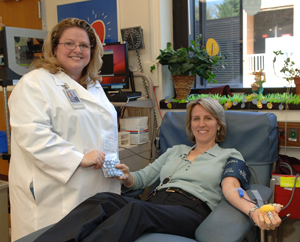 |
| Dr. Barbara Bryant gives Maureen McDonnell her pack of iron supplements when she comes to donate. |
Clinical Center researchers are giving iron supplements to donors with low iron and low hemoglobin levels. Researchers want to know if this could help treat and prevent iron deficiency in people who donate regularly or would like to donate regularly.
Dr. Barbara Bryant, a clinical fellow in the CC Department of Transfusion Medicine, is the principal investigator of the study known as IRON, which stands for Iron Replacement or Not. She says the NIH blood bank may be the only blood bank doing a large-scale study on iron replacement for donors.
"If we prove that iron replacement for donors can be done safely and efficiently in blood banks, it has the potential to increase the blood supply by decreasing the number of donors who are deferred," explains Bryant.
When people donate blood, they lose about one-quarter of the storage iron in their body. Some people rebuild their iron stores quickly, through diet, and are ready to donate again in about two months. But other people do not rebound as quickly. If people are iron depleted or deficient, it will show up during the donation screening process, when a fingerstick blood test is done to measure hemoglobin levels. People who do not meet the required hemoglobin level for giving blood are temporarily deferred from donating—sent home and told to come back and try again in a month or two.
At the NIH blood bank, people who do not pass hemoglobin screening are invited to talk with Bryant and colleagues about participating in her study. But before passing out iron pills, Bryant does an extensive screening questionnaire and more blood work to make sure there is no serious underlying problem causing the low hemoglobin levels. If nothing abnormal is found, people are then asked to be part of her protocol. Participants take supplements for 60 days, return for follow-up, and if they pass their hemoglobin screening, they are allowed to donate.
Maureen McDonnell, a management analyst in the CC Office of Workforce Planning and Development, says she had low hemoglobin during her three pregnancies so she was not surprised by her fingerstick test result at the NIH blood bank. She now is taking iron supplements as part of the study and says she is experiencing the benefits of the boost in iron. "I don’t feel as tired mid-day. I am much more energetic. And, I’ve been able to donate again, so that feels good too."
Both men and women can become iron depleted or deficient. But Bryant says the problem is more common in women, particularly those who are pre-menopausal. Women have smaller iron stores than men to begin with, plus they lose iron with their monthly menstrual cycle and they require a lot of iron during a pregnancy.
Feeling tired, or craving unusual things like ice or dirt, are some of the symptoms of low iron. Sherri Gollins, a dental hygienist in NIDCR, says there was a time when she preferred to chew ice rather than eat food. She says her iron deficiency was detected when she went to donate blood. Her desire for ice dissipated within the first week of taking iron supplements and after about three weeks, she noticed her energy level was improving. "I’m honored to participate in the study," Gollins says. "Now that I’m better, I want to do what I can to help other people."
This is the first time both McDonnell and Gollins have participated in an ongoing CC trial. Both say it’s been a positive and educational experience. "I was pretty excited to see first-hand what this place is all about, and very glad to be able to contribute to somebody’s research," McDonnell says.
Bryant is in the second year of a three-year study. She is recruiting both patients with low hemoglobin levels as well as patients with good levels who would be part of the control arm of the protocol.
"I like studying blood," Bryant says of her career in blood banking, first as a technologist and now a clinician. She says having a good supply of blood is a huge challenge and deferring donors is frustrating to donors and blood centers.
"The practice of giving iron replacement to donors is probably a good thing," Bryant says. "The blood banking community has acknowledged it, but nobody has had the resources to do this study. That’s where we came in. This is a fabulous opportunity here at the NIH."
Dr. Barbara Bryant gives Maureen McDonnell her pack of iron supplements when she comes to donate.
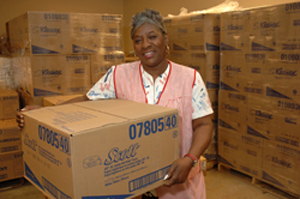 |
| Martha Parris, CC housekeeping aide, retires.
|
After leaving the CC, Parris will move from Washington to Waldorf, Md., to "do nothing but rest and enjoy" her children, Michelle and Jason, and her grandchildren, Dij and Dominique.
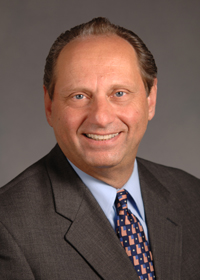 |
| Robert DeChristoforo, interim chief of the Clinical Center Pharmacy Department
|
Only three other CC pharmacists currently on staff, as well as two former department chiefs, have earned the designation, which recognizes a high standard of practice excellence of the recipients.
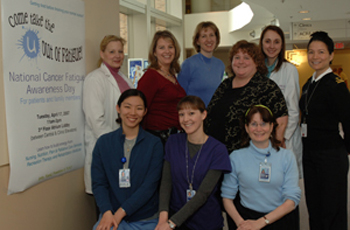 |
| (Back row left to right) Sue Johnson, Julie Hoehl, Kathy Farrell, Georgie Cusack, Rachael Drabot, and Kieu Vu (Front row left to right) Ashley Rodenbach, Laura Wall, and Judy Lowitz were among CC staffers facilitating the event.
|
More than two-thirds of cancer patients undergoing therapy experience cancer fatigue. How cancer fatigue affects patients was the focus of Cancer Fatigue Awareness Day on April 17.
To participate in any of the following studies, call 1-866-444-2214 or TTY: 1-866-411-1010.
Swallowing studies
Volunteers between the ages of 20 and 90 who have trouble swallowing needed to participate in studies (06-N-0212 and 06-N-0120) on swallowing. Transportation available.
Turner Syndrome study
Girls and women with Turner Syndrome, a disorder of the female X chromosomes, needed for a study (00-CH-0219) involving comprehensive evaluation, including cardiac and ovarian function.
Pulmonary sarcoidosis
An NIH study (06-H-0072) seeks adults with pulmonary sarcoidosis.
The following new clinical research protocols were approved in April:
A Phase 1, Multicenter, Dose-Escalation Study of CAT-8015 in Patients with Relapsed or Refractory Hairy Cell Leukemia (HCL), 07-C-0130, Robert J. Kreitman, MD, NCI
Phase 1 Study of Topical Romidepsin in Early Stage Cutaneous T-Cell Lymphoma, 07-C-0133, Maria L. Turner, MD, NCI
A Phase II Study of Combination Oral CC-5013 Lenalidomide (Revlimid ®), Oral Sunitinib, (Sutent) and Low Dose Oral Metronomic Cyclophosphamide for the Treatment of Stage IV Ocular Melanoma, 07-C-0134, Steven K. Libutti, MD, NCI
A Phase II Trial of GW786034 (Pazopanib) in Subjects with Recurrent Glioblastoma, 07-C-0138, Howard A. Fine, MD, NCI
Pilot Study of the Incidence of HLA Class I and Class II Antibodies in Platelet Donors and their Effects on the Transfusion Recipient, 07-CC-0125, David F. Stroncek, MD, CC
Pilot Study of the Metabolic Effects of Betahistine Hydrochloride (Obecure) in Overweight Women, 07-CH-0126, Lisa B. Yanoff, MD, NICHD
Gadofosveset Imaging of Chronic Total Peripheral Artery Occlusion (CTO), 07-H-0128, Robert J. Lederman, MD, NHLBI
Selective Depletion of Alloreacting T Cells Using a Photodepletion Technique to Prevent GVHD after HLA-Matched Peripheral Blood Stem Cell Transplantation for Subjects with Hematologic Malignancies, 07-H-0136, Stephan Mielke, MD, NHLBI
Pilot Study of a Multi-Drug Regimen for Severe Pulmonary Fibrosis in Hermansky-Pudlak Syndrome, 07-HG-0132, Thomas C. Markello, MD, NHGRI
Functional Neuroanatomy of Emotion Perception, Recognition, Learning, and Memory, 07-M-0127, Peter A. Bandettini, PhD, NIMH
PET Evaluation of Brain Peripheral Benzodiazepine Receptors Using (11C)PBR28 in HIV-Seropositive Patients with (MCMD), 07-M-0129, Amira K. Brown, PhD, NIMH
A Study to Evaluate and Characterize the Ex Vivo Effect of Pharmacological Chaperone Therapy in Blood Cell Lines Derived from Patients with Gaucher Disease, 07-N-0131, Raphael Schiffmann, MD, NINDS
Expanding the Phenotype of the LRRK-2 Mutation in Individuals with History of Parkinson’s Disease and their Relatives: a Prospective Study, 07-N-0137, Grisel J. Lopez, MD, NINDS
Cross-validating NIRS with fMRI, 07-N-0139, Eric M. Wassermann, MD, NINDS
June 6, 2007
Mechanisms of Fibrotic Tissue Remodeling in Chronic Infectious Disease
Thomas A. Wynn, Ph.D., Senior Investigator, NIAID
Using Medicare Data in Health Services Research
Leighton Chan, M.D., M.P.H.
Chief, Rehabilitation Medicine Department, CC
June 13, 2007
Modifying Anti-Beta Cell Immune Responses to Preserve Insulin Production in Type 1 Diabetes Mellitus
David M. Harlan, M.D., Chief, Diabetes Branch, NIDDK, Professor of Medicine, Uniformed
Leptin Signaling Pathway Genes in Pediatric Overweight
Jack Yanovski, M.D., Ph.D.
Head, Unit on Growth and Obesity, Developmental Endocrinology Branch, NICHD
June 20, 2007
Contemporary Clinical Medicine: Great Teachers
John Laws Decker Memorial Lecture
The Microscope as a Tool for Disease Discovery
Elaine S. Jaffe, M.D., Chief, Hematopathology Section, Acting Chief, Laboratory of Pathology, Center for Cancer Research, NCI
June 27, 2007
Chemokine Control of
Philip M. Murphy, M.D., Chief, Laboratory of Molecular Immunology, NIAID
Amy Guillet Agrawal, M.D., Director of Simulation, Critical Care Medicine Department, CC
|
Clinical Center News, National
Institutes of Health, Building 10, 10 Center Drive, Room 12C440, Bethesda, MD 20892-1504. Tel: 301-496-6787.
Fax: 301-402-2984. Published monthly for CC employees
by the Office of Communications, Patient Recruitment, and Public Liaison. News, article ideas,
calendar events, letters, and photographs are welcome.
|
This page last reviewed on 02/28/11
 The information on this page is archived and provided for reference purposes only.
The information on this page is archived and provided for reference purposes only.
|
|